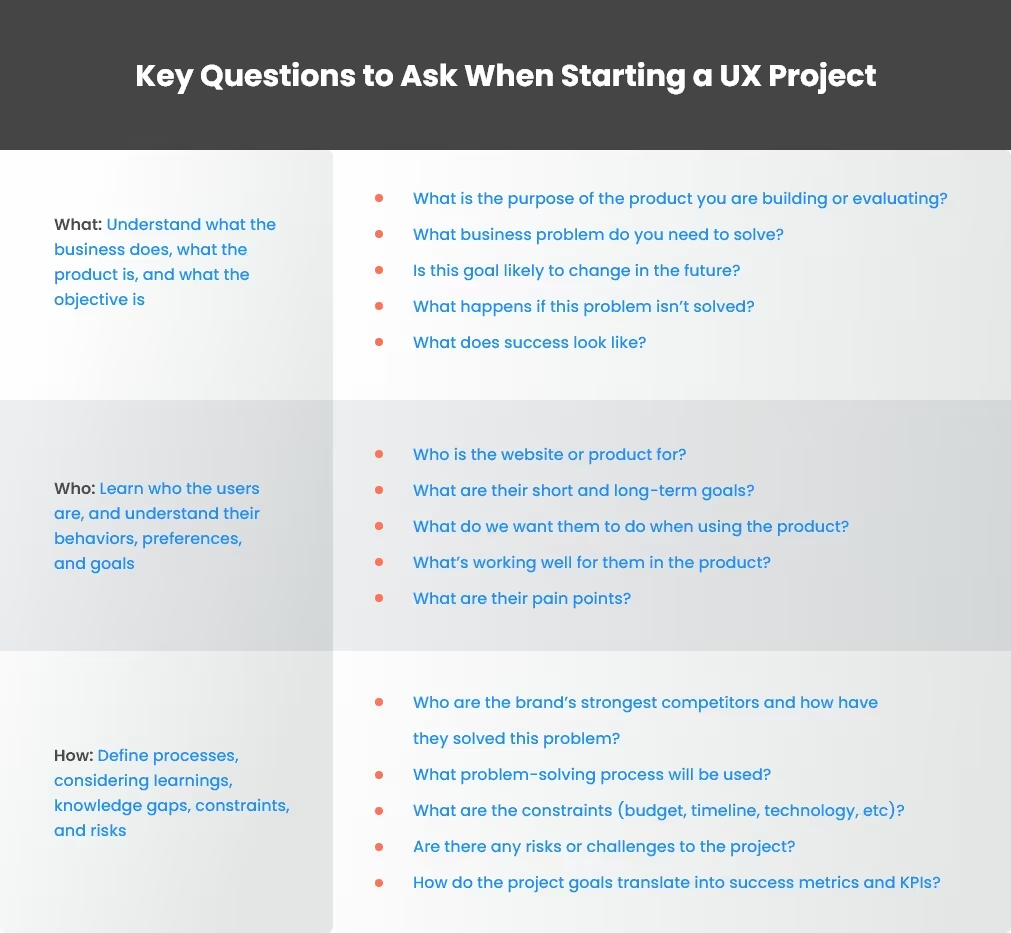User experience — good or bad — affects how customers feel about your product or brand.A good user experience (UX) creates positive feelings in the customer's mind and increases the chances of them returning. A poor user experience, on the other hand, can create negative emotions and reduce loyalty. To be successful, businesses need to pay special attention to UX.But when embarking on a UX project, it’s easy to become unfocused and lose sight of the end goal. There are a lot of problems that UX designers can solve, but it’s important to correctly prioritize and solve the right ones. Here is a UX project kick-off checklist with questions to help you gather context and pick out the important problems so that your project gets off to a good start. We’ve broken these down into three overarching sections that take you through the what, who, and how of the UX design process.
What: Identifying the objective

The first set of questions in any UX project kick-off checklist should be tailored towards understanding what the business does, what the product is, and what the objective of the project is.
- What is the organization’s business model?
What does the organization do? Understanding the business context and goals will help you address their challenges in a meaningful way.
- What is the purpose of the product you are building or evaluating?
Understand the product’s unique value proposition (UVP). Also, understand how it fits into the brand’s overall strategy.
- What business problem do you need to solve with this project?
Whether your current project is intended to build a new product or redesign an existing product, try to uncover the business objectives behind this. Aim to arrive at specific, measurable, and meaningful desired outcomes, such as increases in conversion rate or net promoter score.
- Is this the right problem to solve?
Consider whether there are any other areas that could potentially generate more value if addressed first.
- Is there any previous documentation or data that can help shed light on this problem?
Documentation may exist in the form of personas and user flows, while data may reside in the form of Google Analytics data, survey inputs, anecdotal feedback, and so on.
- Is this goal likely to change in the future?
Goals might shift over a period of months for organizations that are growing and evolving or those that operate in industries that are highly volatile. UX designers should be aware of the factors influencing this.
- What happens if this problem isn’t solved?
Consider the implications of not solving the problem at hand. Understanding the impact on the business will help clarify the motivations behind the project.
- What does success look like?
What information should users receive and what kind of experience should they have? What would change for the business if the project is a success?
Who: Understanding the users

Next, spend some time understanding who the users of the product are, their behaviors, preferences, and goals.
- Who is the website or product for?
There could be different types of users. For instance, an ecommerce marketplace might have two sets of users — buyers and sellers — and each would have its own set of needs, expectations, and behaviors. Categorize the types of users that will be using your product and create personas for each type.
- If there are existing users, what demographic do they belong to?
Define their age, gender, location, and any cultural factors. What channels are they actively using?
- What are their short and long-term goals?
What do they need or want to achieve? What’s important to them, and why do they care about this product?
- What do we want them to do when using the product?
Define the conversion actions you want users to take, such as registration or making a purchase.
- What’s working really well for them in the product?
If you’re evaluating a product that’s already in use, learning which features users find most helpful can shed some light on their preferences and expectations.Read How to Create the Best Color Palette for Your Product’s UI
- What are their pain points?
Similarly, understanding what users struggle with, and which parts of the solution cause stress and frustration for them, is critical to designing good experiences.
- Is it possible to set up interviews with actual users to collect specific insights?
Existing data might not reveal all aspects of your users’ experience of the product. In-depth interviews might help unearth challenges you may not have found otherwise. Read our Guide to Building Natural User Interfaces
How: Establishing the right processes
Now, it’s time to start defining a roadmap for your UX project. The next questions on your UX project kick-off checklist should be focused on identifying learnings, knowledge gaps, constraints, and risks while defining the problem-solving process to use.
- If previous attempts have been made to solve the problem, what was the approach?
UX project kick-off meetings should include stakeholders who have been a part of any previous attempts to address this particular challenge. Document any findings from previous attempts, as well as any learnings from failed attempts.
- Who are the brand’s strongest competitors and how have they solved this problem?
Considering competitors’ approaches can give you some insights to help shape and inform your own.
- What problem-solving process will be used?
If there’s a methodology or process you plan to follow, define it and outline the steps to take.
- Is there any further user research that needs to be done?
If there are any areas where fresh user research needs to be conducted, define these.
- Is there any domain-specific knowledge needed?
Consider whether there is any industry or niche-specific knowledge you need to acquire before starting the project.
- What’s the budget and timeline?
Understanding the constraints you have to work within will help you effectively plan the resources at your disposal.
- Are there any technology constraints?
If the stakeholders expect certain preferred technologies or tools to be used, this could affect your choice of tools and platform.
- Are there any risks or challenges to the project?
Try to anticipate any risk factors or challenges that could affect the successful completion of the project.
- Who are the stakeholders?
Identify the business stakeholders as well as those responsible for making key decisions on the project.
- How do the project goals translate into success metrics and KPIs?
Identifying ways to measure success qualitatively and quantitatively is critical to demonstrating business value.

Set your project up for success with the right questions
Asking the right questions will help you closely understand the rationale behind the project, the target audience, the desired outcomes, and business risks. Here's what you can expect to gain by carefully considering all the questions in this UX project kick-off checklist:
- A precise understanding of the business challenge and the end goal of the project
- A data-powered understanding of your target market and audience
- An idea of current and future bottlenecks in your process
- A clear understanding of the user flow and information architecture
By starting out with a systematic effort towards understanding critical aspects of the project, you will be able to effectively plan resources, define processes, and mitigate risk — setting you up for success with your UX project. Read 6 Key Steps to Performing a UX Audit
.avif)









.jpg)









